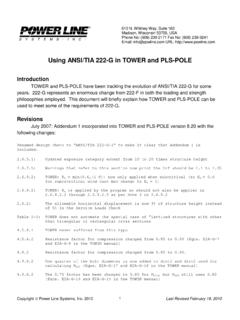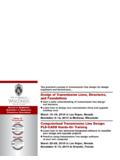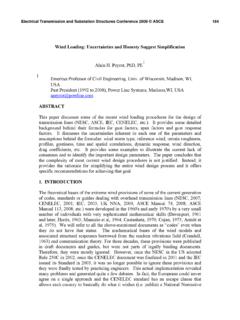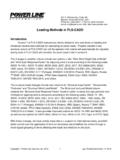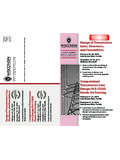Transcription of Loading Methods in TOWER and PLS-POLE
1 Copyright Power Line Systems, Inc. 2016 Last Revised November 17, 2016 1 610 N. Whitney Way, Suite 160 Madison, Wisconsin 53705, USA Phone No: (608) 238-2171 Fax No: (608) 238-9241 Email: URL: Loading Methods in TOWER and PLS-POLE Introduction Version 7 of PLS-POLE and TOWER introduces several new Methods and modifies many of the existing ones for applying wind & ice loads to a structure. The new options include automatic Loading as per ASCE 74-1991, ASCE 74-2009, NESC 2002, 2007, 2012, 2017, IEC 60826:2003, IS802:1995 (India), EN 50341-1:2001, EN 50341-1:2012, EN 50341-3-9:2001 (UK), EN50341-2-9:2015 (UK), EN 50341-3-17 (Portugal), EN50341-2-22:2016 (Poland), REE (Spain), Russia 7th/SNiP, ISEC-NCR-83 (Israel), TPNZ (New Zealand), ESAA C(b)1-2003, AS/NZS 7000:2010 and AS/NZS 7000:2016. The existing options that have been simplified and integrated into the new Loading methodology include: Wind on All, Wind on Face, SAPS Wind, RTE Hyp1 and RTE Hyp2.
2 TIA/EIA 222-F and ANSI/TIA 222-G have been left unchanged. Selecting a wind Loading method can result in the automation of a number of calculations: 1) Calculation of the structure gust response factor 2) Adjustment of wind speed with height 3) Automatic selection of a drag coefficient for poles (as a function of number of sides or Reynolds number) and for lattice towers (as a function of solidity ratio) To support these new Methods , a new column, Wind/Ice Model, is now available in the vector and wire load case tables. In addition to this column we have added Structure Ice Thickness and Structure Ice Density columns so that ice may be applied to a structure. Finally, you will find a Wind Area Factor column which can be used to adjust the wind load on the structure in the same manner that the Dead Load Factor adjusts the dead load. Revisions Version ASCE 74-2006 (draft) made available Automatic calculation of Kcom for UK NNA users (see the technical note for more information) Version NESC 2007 added which is effectively identical to NESC 2002.
3 Version ASCE 74-2009 replaces ASCE 74-2006 (draft) now that the manual has been published. Version AS/NZS 7000:2010 introduced Version NESC 2012 added which is effectively identical to NESC 2007. Version IS 802 : 1995 introduced Copyright Power Line Systems, Inc. 2016 Last Revised November 17, 2016 2 Version EN50341-1:2012 introduced Version Russia 7th/SNiP introduced Version ISEC-NCR-83 introduced Version NESC 2017 introduced (effectively identical to NESC 2012) Version EN50341-2-9:2015 (UK) introduced Version EN50341-2-22:2016 (Poland) introduced Version AS/NZS 7000: 2016 introduced Notes for Users of Previous Versions Models made in previous versions open in version 7 without requiring any modifications. Any necessary translation will be performed automatically and an analysis of a structure model in version 7 will produce the same results as it did for that model in version 6.
4 You do not need to make any changes to keep working the way you always have. However, you may want to modify your models and Loading criteria to take advantage of the new options offered in version 7. Getting Started with the New Methods PLS-POLE models do not require any changes to use the new Loading Methods . Should you wish to take advantage of them, you need only select the method in the Wind/Ice Model column and input the appropriate Terrain Category in the Loading Method Parameters dialog reached from the Vector Load Cases or Wire Load Cases table. Please note that when using an automated method, you should input basic unadjusted wind pressures (normally at 10m or 33ft above the ground) in the Transverse and Longitudinal Wind Pressure columns. If you then run an analysis with the new method the following will occur: the appropriate drag coefficient will be selected based on pole shape and/or Reynolds Number (overriding whatever you input), the wind pressure will be adjusted with height, the basic input wind pressure will be adjusted by the Wind Area Factor and will also be adjusted by the calculated structure gust response factor and finally, ice will be applied to the pole.
5 These effects are detailed in the Detailed Pole Loading Data for Load Case table in the Analysis Results report. You should carefully review this table for your preferred code as it supplies in one place all the information necessary to understand what loads the program calculated and applied to your pole. Note that ice will only be applied to your structure if you input a non-zero ice thickness and that most codes (including NESC and ASCE) do not require ice to be applied to the structure even for load cases that specify ice on conductors. If you do input an ice thickness, the ice will only be applied to equipment, cables, guys, angles and the pole itself. Due to a lack of guidance on how ice accretes on arms, braces and insulators, ice is not applied to these elements. Copyright Power Line Systems, Inc. 2016 Last Revised November 17, 2016 3 In order to use the new Loading Methods with TOWER models you may need to make some modifications.
6 If you elect to use a method that only applies wind on the face of the structure, such as ASCE74-1991, ASCE74-2009F (but not ASCE74-2009M), NESC 2002, IEC 60826, IS802:1995, EN 50341, UK NNA, Portugal NNA, REE (Spain), Russia/SNiP, ISEC-NCR-83, TPNZ, ESAA C(b)1-2003, AS/NZS 7000:2010F and others, you should do the following: 1) Open the General/General Data dialog and modify these settings: A) Select the cross-section shape (rectangular or triangular) of the structure body. B) Check the Allow separate faces for each section checkbox. This will allow you to control the shielding effects of one portion of the structure on another and is required for delta configurations and chainette structures. C) Input a Ground Elevation Shift for Wind Height Adjust if the structure is not resting directly on the ground. 2) If you have not already defined sections, do so using Geometry/Sections/Table Edit.
7 In general, you should create sections at the border of a discontinuity in TOWER outline, to separate parts of the TOWER where the solidity ratio can be expected to substantially differ and for each mast of a chainette. Section heights should not exceed the maximum allowed by the code for zones over which wind pressure can be assumed constant. You should always have a clean boundary between two sections in the horizontal plane even when overriding section membership manually in the Geometry/Angle Members table. Note that loads (wind and dead) are divided evenly among all joints in a section, so placing your entire TOWER in a single section will result in a conservative distribution of dead load. 3) Input appropriate factors in Geometry/Sections/Table Edit for the Transverse and Longitudinal Area Factor (CD From Code) columns to account for any members that were not included in the TOWER model.
8 The factors in these columns are used by any Loading method that calculates a drag coefficient for a section as a function of the solidity ratio (ASCE74, IEC60826, IS802:1995, EN 50341, UK NNA, Portugal NNA, REE, TPNZ, ESAA C(b)1 and AS/NZS 7000:2010 Methods ), NESC and others. You will note that columns corresponding to the other Methods also exist, such as: Transverse and Longitudinal Drag x Area Factor for Face (Wind on Face method), Af and Ar Factor For Face EIA Only (TIA/EIA 222-F and G Methods ), Transverse and Longitudinal Drag x Area Factor For All (Wind on All method), SAPS Angle and Round Drag x Area Factor (SAPS, ASCE74-2009M, AS/NZS 7000:2010 M, RTE Hyp1 and RTE Hyp2 Methods ). Finally, you may notice a new column at the end of the sections table titled Force Solid Face. This can be used to Copyright Power Line Systems, Inc. 2016 Last Revised November 17, 2016 4 override the calculated face area of a section with the gross area and can be useful for areas where the face computation is uncertain or one wishes to be conservative such as the transverse face of a crossarm.
9 This setting only applies to section based Loading Methods and not to member based Methods (such as Wind on All, SAPS, ASCE74-2009M, AS/NZS 7000:2010M, RTE Hyp1 and RTE Hyp2). A drag coefficient of 2 is always used with a solid face; however, you can modify this by inputting whatever Transverse and Longitudinal Area Factor (CD From Code) you find appropriate. 4) Inspect the transverse and longitudinal faces that TOWER automatically determined. TOWER was designed to automatically identify the faces for conventional lattice structures. If you have a chainette or otherwise unconventional structure, or simply don t like the face that TOWER identified, you can use the new Geometry/Members/Override Face and Geometry/Members/Fence Override Face commands to define your own face. Face overrides are stored in the Geometry/Members/Capacities and Overrides table should you want to edit them in a tabular format.
10 5) Run an analysis of your model and carefully inspect the detailed sections Loading table Section Load Case Information printed in the Analysis Results report. This table includes within it all the data you need to understand how TOWER calculated the load on this section and what that load was. For each type of TOWER you model, you should make sure that the gross area the program calculates using your section and face definition matches your expectations. Note that the ice load printed in this table is multiplied by the Sections Dead Load Factor for this section. Since the Sections Dead Load Factor is intended to account for the effects of members that were not included in the model, it is used to modify the ice load calculated for the section. Note: we strongly encourage you to graphically review the member type (truss, beam or tension only), section membership and face settings of all members in your structure.

